Proven Frameworks to Quickly Validate Your Business Idea

It’s exciting, isn’t it? And it’s almost frightening how quickly that idea can grow — and how protective you come to be of it.
In fact, for most people, a new business idea is more like a baby than a seed — a precious baby, brimming with immeasurable potential.
It is indeed hard to not let a new business idea become your baby. After all, you devote hours of your time to nurturing it, agonizing over the perfect name, and perhaps even feeding it with your own money. However, becoming too emotionally invested can blind you to some hard truths and get in the way of making hard decisions.
I’m talking here about idea validation. Many people are afraid to go through the necessary business idea validation process because they don’t want to hear that something might be wrong with their idea. And sadly, most of these ideas never develop into a mature form.
Your product or business model needs to have the substance and stability to stand up as an entity in its own right, not just an imaginary construct. In order for it to develop and mature, you must keep in mind that your customers will be real people, not imaginary. So, you need some real processes that involve real people to give you real feedback.
Most importantly, you need the right mindset — a learning-driven mindset. This comes about by acknowledging, accepting, and embracing the fact that no ideas are perfect, all products have risks, and so they need to be validated.
Why is it necessary to validate your business idea?
No matter how good you think your business idea may be, chances are there are things that could make it better. Depending on the problem you need to solve or the service area you want to address, it may not even be the “right” idea at all. It’s better by far to fall in love with a problem, not a solution.
Most software developers start off concentrating on the features or the mechanics of their idea — here’s what my product can do, here’s how it does it, and here are the bells and whistles that make it shine while doing so.
This “feature-driven mindset” is not the right way to go. After all, what happens if all those fine features you’re proposing are inappropriate for the task at hand? What if they don’t resonate or “click” with the buying public, or the user base?
A better approach is to acknowledge that there are no certainties with any product or business idea and that every concept needs to be open to change or evolution.
Testing or validating your ideas is the correct path to take if you want to identify potential risks early on.
It’s also the avenue that leads to the flexibility you’ll need to pivot if necessary — to find new ideas, change your Value Proposition, or identify a new Unique Selling Point (USP) that will make the product stand out.
The key is to adopt a startup approach and experiment as much as possible. Invite feedback, fail fast, and carry on with idea validation until you strike a winning balance.
Going through the process of verification won’t necessarily kill your product — though you may end up with a different product than the one you initially envisaged. More often it’s a good thing, especially if the end result more than meets the goals and criteria you set out at the start of the project, or even satisfies new ones.
And just as you shouldn’t be shackled by the limitations of an initial concept or set of features, neither should you feel constrained by the fact that you and others may have put real money into the project.
Indeed, instead of treating investment as a platform for bulldozing ahead with the initial plan, treat funding as a “runway” to validate the product, make any necessary changes and fix problems early. After all, it may prove difficult or even impossible to fix problems later on.
Criteria for evaluating your business idea
There are four main qualities you can use for idea validation:
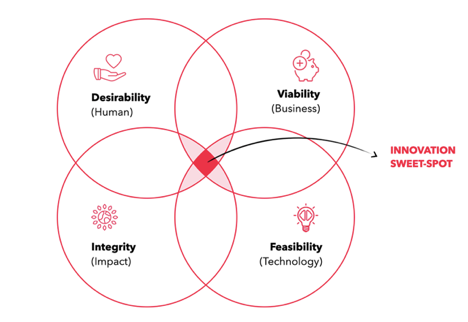
Image source: boardofinnovation.com
- Feasibility: Can it be built?
- Viability: Can you make a business out of it? Will it be sustainable and scalable?
- Desirability: Do people want your product or service?
- Integrity/Ethics: How does business impact society and the environment?
You’ll need to deeply consider all four — and each one’s degree of relative importance to the success of your project like a startup idea. You’ll also need to establish and monitor sensible metrics relating to each criterion to gauge this success.
Does it ever make sense not to evaluate these criteria? Well, this type of verification is something that really only concerns innovative products and businesses. There’s not much mileage to be had from idea validation of repeatable and well-studied business cases or existing solutions that has proven its value over several generations.
For example, if you want to open a bakery, you should focus your efforts on execution and creating a business plan. There will still be some unknown factors like localization or local competitors but the idea itself is already well-tested, sound, and valid.
As such, comprehensive idea validation should be reserved for new, innovative projects that are looking for a scalable business model and present a level of uncertainty.
Starting off on the right foot
Steve Blank, Silicon Valley entrepreneur, defines the startup like this: “A startup is an organization designed to search for a repeatable and scalable business model.”
So, a startup can be a brand new seed-funded business, an innovative product in an existing corporation, a venture project in the innovation lab, etc. No matter which best describes your startup project, they all have one thing in common — at the beginning, there are a lot of unknowns, and so there will be a lot of assumptions on how to design and scale the business model.
Assumptions pose substantial risks to the success of the project. This emphasizes the importance of validating your assumptions early on.
Doing so provides the leeway to pivot if necessary. And I say it again — funding is the key resource that provides the crucial runway you need to validate and iterate on the business model early on.
Unfortunately, too many people skip this step. They get an idea, fall in love with it, organize some funding, and then just charge at it, hoping for the best.
In other words, they focus on building the thing right, rather than building the right thing.
This, essentially, is the feature-driven mindset I spoke of earlier.
Rather than becoming obsessed with specific tools, the mindset that will pay dividends is the one that’s continually learning and responsive to discovery. This kind of thinking enables you to learn what’s going right and what’s going wrong — and then do something about it.
Two mindsets:
- Feature-driven mindset: “I need this feature, and that feature, and machine learning, and..., and…, and…”
- Learning-driven mindset: “I need to learn if users have problem X; I need to learn what products currently solve the problem; I need to learn what the strengths and weaknesses are in those solutions; I need to learn what real users want from a new solution…”
4 frameworks for validating ideas
The very idea of “validating business idea” is by no means new. There are many frameworks and methodologies that incorporate this concept and enable entrepreneurs to validate ideas.
The most “high-level” and well-known are those that tend to interrelate and are usually influenced by one another. For example, Lean Startup was greatly inspired by Customer Discovery, while Google Design Sprints make use of principles found in Design Thinking and Lean Startup.
Here’s a brief rundown of these major frameworks.
Lean Startup
This idea validation framework puts its emphasis on validated learning and getting your priorities right at the start. When you focus on identifying the right thing to build (what customers want and will pay for), you don’t need to spend months waiting for a product beta launch to change the company’s direction. Instead, entrepreneurs can adapt their plans incrementally, as time and circumstances demand it.
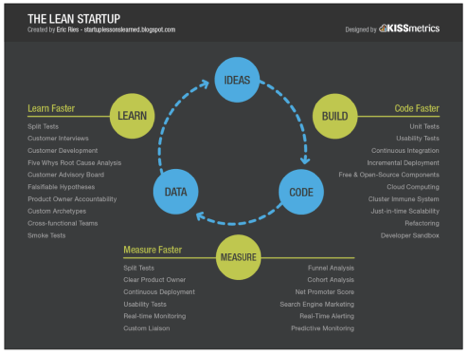
Image source: bigjump.com.au
Customer Development
Created by Steve Blank, the Customer Development framework is all about gathering evidence to test hypotheses, gaining a deep understanding of customer problems, and validating the solutions you come up with.
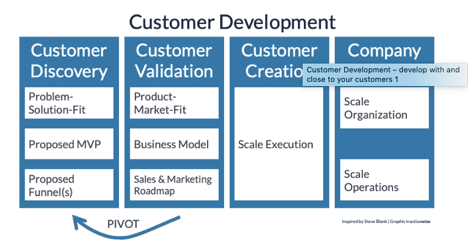
Image source: tractionwise.com
Design Thinking
This is the “test” idea validation stage, which employs a wide range of methods. Many of these stem from the methodologies typically used during Human-Computer Interaction (HCI) and User-Centred Design (UCD) tests.
Testing may be conducted throughout the progress of a Design Thinking project. However, it is most commonly performed at the same time as the prototyping stage. In all cases, the end goal is to design a solution that satisfies the tests of desirability, feasibility, and viability.
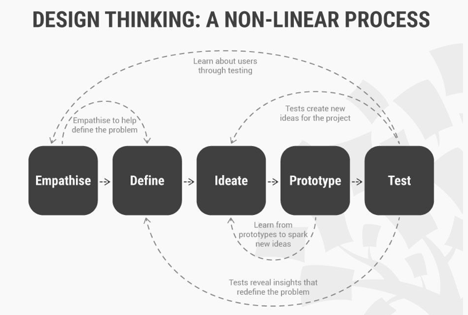
Image source: interaction-design.org
Google Design Sprints
Google Design Sprint is a Design Thinking method, consisting of a time-constrained, five-day process for answering critical business questions through design, prototyping, and testing ideas with customers. The sprint gives teams a shortcut to learning without having to build or launch a Minimum Viable Product.
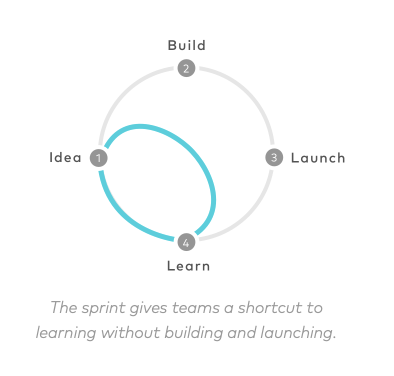
Image source: gv.com
Further reading on the topic of idea validation frameworks
There are some nice books that cover these topics. Testing Business Ideas, by Strategyzer explains how to increase the success of any venture by providing a practical guide to rapid experimentation. The book aims to reverse the statistic that dooms seven out of ten new products to fail to deliver on expectations. It explains how a systematic idea validation process can dramatically reduce risk, and increase the likelihood of success for any new venture or business project.
Available for free reading online, The Real Startup Book gives guidelines on managing innovation projects where the business model is partially or completely unknown. The book argues that the way to resolve the mystery surrounding these parts of your business model is to do research and experiments in the real world with your customers.
Our approach
Our product team here at Netguru uses a idea validation approach which is partially described in the Strategyzer book, with some modifications. Our validation process consists of the following steps:
1. Ideate
Using, for example, Design Thinking or common brainstorming techniques, first form a mental image of the product or concept. We use them during Product Design Sprints.
I like to jot a few things down at this point but everything’s still rough and open to change, replacement, or rejection.
It is the very basis of the idea.
2. Create the initial Lean Canvas
The Lean Canvas is a sketch of the business that can fit onto one page. Here’s where you take notes from step one and start trying to fit them together. If you’re starting with a greenfield concept as your initial idea, you should concentrate mainly on the Customer Segments, Problem, and Unique Value Proposition. These will allow you to state your key assumptions about the desirability of the business.
Key questions you might ask at this point could include:
- Are there people who have a real pain or need?
- Who are they?
- What kind of value do they seek?
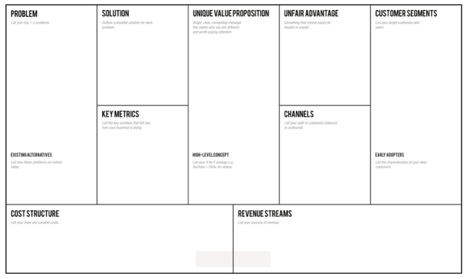
Image source: leanstack.com
Creating the canvas is an iterative process, so it doesn’t need to be perfect at the first attempt.
The idea is to map critical assumptions about your business to prioritize your validations.
Note that the high-risk assumptions which you should identify, test, and take care of first are the critical “leap of faith” assumptions that can render your whole idea useless if they are invalidated!
3. The Opportunity Solution Tree (optional)
This is an optional but interesting exercise you can try to run the validation process and look at your business idea from different angles. An Opportunity Solution Tree (OST) is a visual aid that provides a visual plan for how you can reach a clear, desired outcome. You can use the Opportunity Solution Tree to seek alternative approaches to your stated problem, and to explore other possibilities.
Here’s an example:
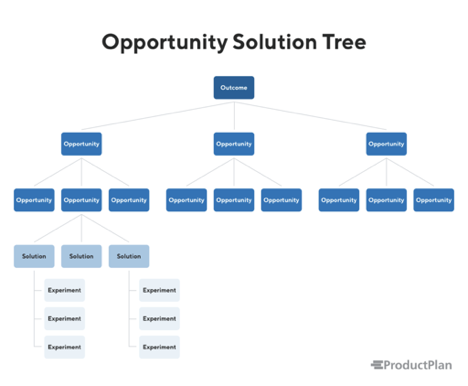
Image source: ProductPlan.com
4. Evaluate risk
After you have created your first version of the Canvas, it’s important to evaluate the risk and identify the elements that still need to be included in idea validation. For this, we use a very simple technique — a 2x2 matrix, plotting “Important” vs “Proof”. This is a common methodology used in Lean Startup, and Design Thinking.

Image source: Kromatic.com
On one axis we have the risk level (Importance) for our business. On the other, we have Proof — a measure of the evidence which proves that the assumption is true. Some evidence will be stronger than others. For example, someone telling us that they would buy our product is weaker evidence than having someone actually give us credit card details in a simulated buying process.
After completing this exercise, we will have one quadrant of the matrix which contains very important assumptions for which we have very little proof. These are the ones we should tackle first!
Once you have established what’s important, you can put the items into a second 2x2 matrix illustrating how easy or hard each goal is to realize.
A typical plot with sticky notes representing each assumption might look like this:
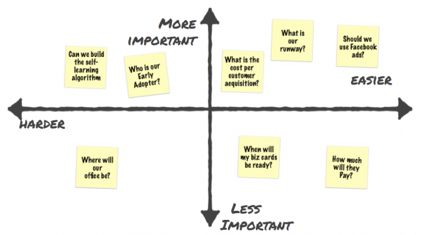
Image source: Kromatic.com
5. Test hypotheses
In this stage, we take the riskiest assumption and convert it into the hypothesis — “Why is it important?”
Validating business ideas is more like a science than an art.
So, we want to follow the approach that will best help us confirm or reject our assumptions in an organized manner, based on our experiments and data. The idea is to have a structured and methodical approach to the treatment of our hypothesis.
There are many ways in which we can create a good hypothesis for our business assumption. For example, The Hypothesis Checklist takes a systematic approach to examine the change that you are making, the aspect that will change, the success or fail metric, and for how long you are going to run the test.
For example:

Image source: realstartupbook.com
Alternatively, the Strategyzer Test Card provides a blank form in which you can fill out the following fields:
- Hypothesis: We believe that... (our assumption).
- Test: To verify that, we will... (experimentation and action).
- Metric: And measure... (our metrics).
- Criteria: We are right if... (success criteria).
6. Experiment
There are many methods we can employ to conduct experiments. The books I’ve mentioned previously (Testing Business Ideas by Strategyzer, and The Real Startup Book) include extensive lists of experiments that may be used for idea validation. These include Customer Discovery Interviews, Wizard of Oz, Fake Landing Page Test, Comprehension Test, and many more.
Good experiments should be focused on one variable at a time so that the product team can clearly understand what’s affecting the results.
Example experiments
Here’s a selection of experiments that you can easily perform to test and validate your business idea.
Customer Discovery Interviews
This is the easiest, and one of the most efficient ways of validating some initial assumptions. As a rule of thumb, whenever I am in doubt or want to quickly evaluate a concept, I schedule about half a dozen interviews to talk to real people or potential customers. There are several rules to follow when doing these interviews, such as preparing your interview script beforehand, and taking steps to connect with your interviewees on an emotional level.
Comprehension Test
Another very easy experiment to conduct as a part of idea validation, and quite powerful. It’s especially useful for validating the Unique Value Proposition (UVP) — that is, do customers or even understand the value of what your product gives them?
You can conduct a five-second test to help you measure what information users take away and what impression they get within the first five seconds of viewing your design.
The results can help in clarifying issues that cloud or hamper your UVP — is it a problem with the wording? Too much jargon? Is it appealing?
The best way to phrase your Unique Selling Points (USPs) and Value Proposition is to use the exact same words that customers from your target market use during the Customer Discovery Interviews. You can then test them, again using a 5-second (or 10 or 15-second) test. This is a super easy procedure: you show your USP/Value Proposition to the user for 5–15 seconds, hide it, and then ask them to describe it in their own words. Simple yet powerful.
Fake landing page
This is the most common experiment. The technique typically involves buying advertising or generating targeted traffic to a small website that describes the product idea. Prospects confirm their interest by leaving an email address or going through a checkout process that simulates the purchase of the product.
Some tips:
- Create the landing page early on to show the Value Proposition, USPs, and fake buying process.
- Set up proper analytics and tracking (Google Analytics, Amplitude, HotJar, etc.).
- Create a small PPC campaign to drive traffic on the landing page.
- Observe the desired behavior (for example, clicking on the call to action, or signing up for the waitlist).
- Draw conclusions from your data and adjust the landing page content or campaign targeting accordingly.
- Iterate if necessary.
Wizard of Oz
With some products or hypotheses, you may want to provide real value to users in order to test the solution. One of the experiments that allows you to do this is known as the Wizard of Oz (WOZ) test. This involves one or more people (the Wizard or Wizards behind the curtain) manually simulating the functionality of a product without the knowledge of the user. This allows you to test a solution and gain feedback without having to build the fully automated solution.
Some general recommendations
- Organize your hypotheses and experiments, track the results, decisions, and lessons learned.
- Iterate until you validate your key assumptions.
- Afterwards, adapt the continuous discovery mindset and grow your business.
The role of idea validation - final thoughts
A learning-driven mindset is the key to success of your business idea — but it requires you to keep an open mind, and occasionally get your hands dirty. You won’t find the truth about the viability and value of your business idea inside your own head, nor even your own office. You’ll discover it from the views and experience of real, impartial users — so you need to engage your customers as early as possible.
Testing is critical to identify and manage risks. It’s also crucial for providing the insight and flexibility you’ll need to make changes as the project develops and to pivot as necessary to enable the product to fully deliver on its promise.
There are popular idea validation frameworks that you can follow to perform this verification and testing, and plenty of different techniques that will enable you to validate your assumptions in a relatively easy and low-cost manner.
Just as your own baby (if you have one) will have the opportunity to develop and grow through experience and experimentation, so too will your evolving business idea. But it can’t develop in isolation.
So get out of the building, and test your assumptions in the real world, now!
.jpg?width=50&height=50&name=Krawczy%C5%84ski%20Mateusz%201%20(1).jpg)
.jpg?width=240&height=240&name=Krawczy%C5%84ski%20Mateusz%201%20(1).jpg)
